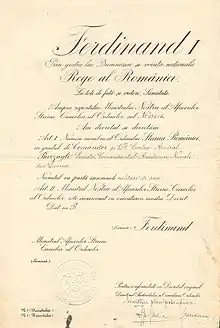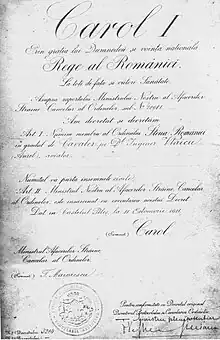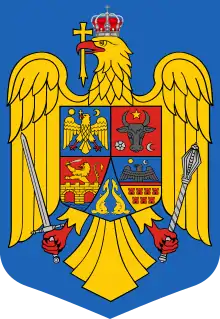| Order of the Star of Romania Ordinul Steaua României | |
|---|---|
 Collar of the Order | |
| Awarded by the King of Romania (1877–1947) The President of Romania since 1998 | |
| Type | Order of Merit |
| Country | Kingdom of Romania Romania |
| Eligibility | (1) Civil, Military; (2) Military units; (3) Foreign citizens |
| Criteria | (1) Exceptional civil and military services to the Romanian State and the Romanian people; (2) For special acts in time of peace or for heroic acts in time of war; (3) For contributing to the development of the friendship relations with Romania, or for other exceptional services to the Romanian State and the Romanian People. |
| Status | Currently awarded |
| Grand Master | President Klaus Iohannis |
| Grades | Collar Grand Cross Grand Officer Commander Officer Knight/Dame |
| Precedence | |
| Next (higher) | Order of Michael the Brave |
| Next (lower) | Order of Faithful Service |
Ribbon of the Order of the Star of Romania | |
The Order of the Star of Romania (Romanian: Ordinul Steaua României) is Romania's highest civil Order and second highest State decoration after the Order of Michael the Brave. It is the oldest Order of Romania. It is awarded by the President of Romania, and has six grades, from lowest to the highest: Knight, Officer, Commander, Grand Officer, Grand Cross, and Grand Cross with Collar.
History
In 1863, Alexandru Ioan Cuza, the Domnitor of the United Principalities of Moldavia and Wallachia, asked the Romanian representative to Paris to contact the then well-known jewellery house Krétly, to manufacture a state decoration. Krétly presented a model, which was immediately accepted by the domnitor, and based on his agreement, 1,000 pieces of the order were made. It was decided that the order would have five ranks: Knight (Cavaler), Officer (Ofițer), Commander (Comandor), Grand Officer (Mare Ofițer), and Grand Cross (Mare Cruce).[1]
Unlike all other decorations in that time that were mostly inspired on the French Légion d'honneur, or which had their insignia like a Maltese cross, the model proposed by Krétly for this order was a blue cross crosslet (cruce repetată), a design that was then unique in decorational design.[1]
The domnitor decided that the name of the honour would be "The Order of the Union" ("Ordinul Unirii"). It was planned to institute the order on 24 January 1864, the date when the 5th anniversary of his election would be celebrated and a moment that marked the unification of the principalities of Moldavia and Wallachia. Because of this, the motto of the new order would fit the event: "GENERE ET CORDES FRATRES" ("BROTHERS THROUGH ORIGINS AND FEELINGS"). The obverse of the insignia would bear the numbers "5" and "24", the days of January when he was elected in both Moldova and Wallachia.[1]
However, due to the overthrow of Alexandru Ioan Cuza by a palace coup, he was unable to actually institute the order, and he awarded the insignia therefore only as a personal present, not as a state decoration. Most of the insignia produced for him remained stored in the Royal Palace's cellars.[1]

In April 1877, when Romania gained independence from the Ottoman Empire, the debate regarding the institution of Romanian decorations was revived. Mihail Kogălniceanu, Minister of Foreign Affairs in the Ion Brătianu cabinet, took part in the debates in the Assembly of Deputies regarding the institution of a state decoration. Because of the already earlier supplied "Order of The Union", it was decided that the shape of the decoration would be the same, modifying only the domnitor's seal. The motto was also changed, because the old one was not appropriate to the moment, to "IN FIDE SALUS" ("IN FAITH IS THE SALVATION"). Regarding the name, Kogălniceanu insisted on "Steaua Dunării" ("The Star of The Danube").[1]
The name "Steaua României" ("The Star of Romania") appeared on 10 May 1877, when the law was voted in the Parliament, as the first law of the Sovereign Romania.[1]
By Royal Decree (no. 1545/1932), King Carol II changed the order of precedence in the Romanian honours system. As a result, in 1932, The Star of Romania dropped in precedence from second place (where it had been since 1906) to fourth place (after the Order of Carol I and the Order of Ferdinand I). In 1937, it dropped to seventh place. The main shape of the order, the blue repeated cross (called also "Romanian cross") was kept, but the rays between the cross' arms were replaced by four heraldic eagles with wings spread, the insignia of King Carol I was placed on the obverse, and the reverse bore the year of its establishment, "1877". Also the number of persons that could be awarded The Star of Romania was increased:[1]
- Knight (Cavaler): 1,000 civilians and 350 military;
- Officer (Ofițer): 500 civilians and 150 military;
- Commander (Comandor): 200 civilians and 75 military;
- Grand Officer (Mare Ofițer): 75 civilians and 25 military;
- Grand Cross (Mare Cruce): 35 civilians and 10 military.

In 1938, the order was given a superior rank, called "Clasa I" (First Class in English), between the Grand Officer rank and the Grand Cross rank, with a maximum of 50 civilians and 15 military personnel.[1]
The statutes established by King Carol II were changed by General Ion Antonescu (who became Conducător on 4 September 1940). Generally, the rules were the ones used during World War I. The order "The Star of Romania" became the second in the national hierarchy, after that of the Order of Michael the Brave.[1]
Inspired by the German Iron Cross, Ion Antonescu decided that the first three grades of the orders the Star of Romania and the Crown of Romania, with spades (swords), and the ribbon of The Medal "The Military Virtue" would be awarded for exceptionally brave acts with an oak leaf, attached to the ribbon.[1]
After 1948, all the existing decorations were outlawed, and their wearing was forbidden. Just by keeping the insignia, one was considered a delinquent in the first years of communism.[1]
In 1993, the idea of reinstating the oldest Order was proposed within the Special Commission of the Chamber of Deputies. After several attempts, in 1998/1999 the National Order "The Star of Romania" was reinstituted, with a design similar to the one used in 1932, but without the insignia of King Carol I, and with the republican insignia.[1]
Grades
As per Law 29/2000, regarding Romania's national system of decorations, there are currently six grades:[2]
- 1st Class: Collar (Colan);
- 2nd Class: Grand Cross (Mare Cruce);
- 3rd Class: Grand Officer (Mare Ofițer);
- 4th Class: Commander (Comandor);
- 5th Class: Officer (Ofițer);
- 6th Class: Knight (Cavaler).
Notable recipients

First issue (1877–1948)
- Ernesto Burzagli
- Archduke Eugen of Austria (1881)
- Aurel Vlaicu (1911)
- Pratap Singh of Idar (1921)
- Jan Karcz
- Aristide Razu (1918)
- Harry Gideon Wells (1919)
- Ismail of Johor (1920)
- Hendrik Pieter Nicolaas Muller (1922)
- Scarlat Cantacuzino
- Artur Phleps
- Edward Rydz-Śmigły
- Jack Corbu (1930)
- Stanisław Maczek
- Amha Selassie of Ethiopia
- Rudolf Walden
- Fritz Witt (1942)
- Martin Unrein
- Jagatjit Singh of Kapurthala (1935)
- Walter Staudinger (1942)
- Ismail of Johor (1942)
- Walther Wenck (1943)
- Emmerich Jordan (1944)
- Samuel C. Cumming
- Paul de Smet de Naeyer
- Joseph Maria von Radowitz
- Klement Gottwald (1947)[3]
Second issue (since 1998)
Foreign citizens
| No. | Name | Known for | Year Appointed |
|---|---|---|---|
| 1 | President of France | 1998 | |
| 2 | President of Peru | ||
| 3 | President of Finland | ||
| 4 | President of Bulgaria | ||
| 5 | President of Poland | 1999 | |
| 6 | President of Austria | ||
| 7 | President of Greece | ||
| 8 | President of Turkey | ||
| 9 | King of Norway | ||
| 10 | Emir of Qatar | ||
| 11 | Emir of Kuwait | ||
| 12 | President of Kazakhstan | ||
| 13 | President of Albania | ||
| 14 | President of Israel | ||
| 15 | President of Moldova | 2000 | |
| 16 | Queen of the United Kingdom | ||
| 17 | President of Portugal | ||
| 18 | President of Hungary | ||
| 19 | Queen of Denmark | ||
| 20 | President of Slovakia | ||
| 21 | President of Croatia | ||
| 22 | President of Mexico | ||
| 23 | President of Brazil | ||
| 24 | King of Thailand | ||
| 25 | President of Ukraine | ||
| 26 | President of Lebanon | 2001 | |
| 27 | Secretary-General of the United Nations | ||
| 28 | Queen of the Netherlands | ||
| 29 | President of Lithuania | ||
| 30 | President of Latvia | ||
| 31 | Prince and Grand Master of the Order of Malta | 2002 | |
| 32 | President of United Arab Emirates | ||
| 33 | President of Philippines | ||
| 34 | President of Slovenia | ||
| 35 | President of Hungary | ||
| 36 | President of the United States | ||
| 37 | Captains Regent of San Marino | ||
| 38 | Captains Regent of San Marino | ||
| 39 | President of Tunisia | 2003 | |
| 40 | King of Sweden | ||
| 41 | King of Spain | ||
| 42 | President of Italy | ||
| 43 | President of Estonia | ||
| 44 | Grand Duke of Luxembourg | 2004 | |
| 45 | Cardinal Secretary of State | ||
| 46 | President of Malta | ||
| 47 | Captains Regent of San Marino | ||
| 48 | Captains Regent of San Marino | ||
| 49 | President of Chile | ||
| 50 | President of Azerbaijan | ||
| 51 | King of Jordan | 2005 | |
| 52 | President of Finland | 2006 | |
| 53 | Professor | 2007 | |
| 54 | Cardinal Secretary of State | 2008 | |
| 55 | Prince and Grand Master of the Order of Malta | ||
| 56 | President of Poland | 2009 | |
| 57 | President of Lebanon | ||
| 58 | Prince of Monaco | ||
| 59 | King of the Belgians | ||
| 60 | President of Moldova | 2010 | |
| 61 | President of Malta | ||
| 62 | President of Latvia | 2011 | |
| 63 | President of Estonia | ||
| 64 | President of Italy | ||
| 65 | Cardinal Secretary of State | 2015 | |
| 67 | President of Portugal | ||
| 68 | President of Lithuania | 2016 | |
| 69 | President of Italy | ||
| 70 | President of Bulgaria | ||
| 71 | President of Germany | ||
| 72 | President of Poland | ||
| 73 | President of France | ||
| 74 | President of Slovakia | ||
| 75 | President of Moldova | ||
| 76 | President of Croatia | 2017 | |
| 77 | King of the United Kingdom | ||
| 78 | Grand Hospitaler of Order of Malta (SMOM) | ||
| 79 | Professor | ||
| 80 | President of Estonia | 2021 | |
| 81 | President of Lithuania | 2022 |
By class
See also
References
- 1 2 3 4 5 6 7 8 9 10 11 12 "Ordinul naţional "Steaua României"". presidency.ro (in Romanian). Retrieved 4 May 2023.
- ↑ "LEGE nr. 29 din 31 martie 2000 privind sistemul national de decoratii al Romaniei". Monitorul Oficial al României. Retrieved 13 December 2015.
- ↑ "Řády a vyznamenání prezidentů republiky". vyznamenani.net (in Czech). 18 December 2012.
- ↑ "Iohannis i-a decorat pe președintele Germaniei şi pe partenera sa" (in Romanian). Mediafax. 22 June 2016. Retrieved 22 June 2016.
- ↑ www.presidency.ro, Decret de decorare semnat de Președintele României, domnul Klaus Iohannis, 29 March 2017.
- ↑ "Romanian president decorates legendary gymnast Nadia Comaneci". www.romania-insider.com. Retrieved 1 September 2022.
- 1 2 3 4 5 6 7 8 "Klaus Iohannis a decorat opt congresmani americani cu Ordinul Steaua României în grad de Comandor". adevarul.ro (in Romanian). June 9, 2017. Retrieved April 29, 2018.
- 1 2 3 4 5 6 7 8 Peia, Florentina; Iacob, Simona (June 9, 2017). Purcarea, Vicentiu; Pandea, Răzvan-Adrian (eds.). "President Iohannis and U.S. congressmen discuss Romania's inclusion in Visa Waiver programme". Agepres. Retrieved April 29, 2018.
- ↑ "Presedintele Basescu i-a retras Steaua Romaniei lui Vadim Tudor". 9am.ro. 2007-05-28. Retrieved 2017-07-08.
Sources
- (in Romanian) Ordinul național "Steaua României", Presidency of Romania website
- (in Romanian) Recipients of the order (Excel sheet), Presidency of Romania website
